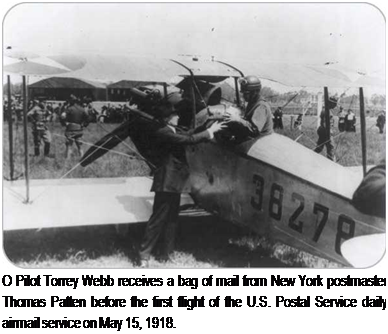Early Commercial Flights
In the early days of aviation, airplanes were small and flew slowly. The public showed little interest in air travel, and businesses did not consider air freight as a way to move their goods around. Not until 1912 did an airplane exceed 100 miles per hour (160 kilometers per hour) to match a railroad train or automobile. Planes were faster than ships, but they could not cross the wide oceans. Nor could they carry more than one or two people at a time.
The first known freight flight took place in 1910, when the Ohio company Morehouse-Martens hired Philip O. Parmalee to fly two packages of silk between its stores in Columbus and Dayton, Ohio. This was a publicity stunt, but the practice of carrying mail by air seemed a good idea and soon caught on.
![]()
|

 AIRMAIL
AIRMAIL
Airmail flights began in September 1911, when the U. S. Postmaster-General awarded pilot Earl L.
Ovington the title of Air Mail Pilot Number One.
On May 15, 1918, the U. S.
Postal Service introduced a daily airmail service between New York City,
Washington, D. C., and Philadelphia. For the first few months, army aviators flew the airmail routes. Civilian pilots were then trained, and
the airmail service was gradually expanded. The first coast-to-coast airmail was delivered in the United States in 1921. The mail left San Francisco at 4:30 a. m. on February 22 and reached Long Island, New York, at 4:50 the following afternoon. Soon, regular flights operated between New York and San Francisco. In 1927, the Postal Service turned its airmail network over to the newly emerging airlines.
In 1912, there were only 2,400 licensed pilots in the world, more than 900 of whom were in France. There were fewer than 200 pilots in the United States. Things changed rapidly after World War I (1914-1918). Aircraft were bigger, faster, and more reliable. There were many more pilots available, trained as military fliers and now released from service. Record-breaking flights, such as the first crossing of the Atlantic Ocean in June 1919 by John Alcock and Arthur
Whitten Brown, showed that longdistance flight was no longer a dream.










